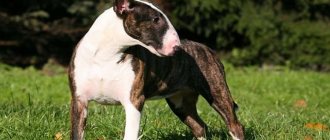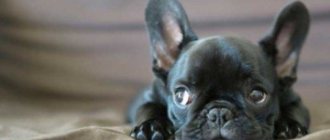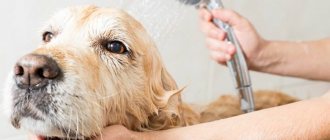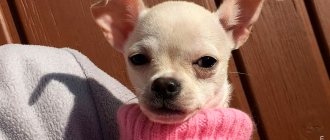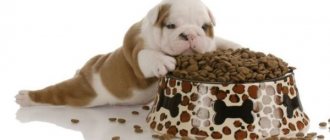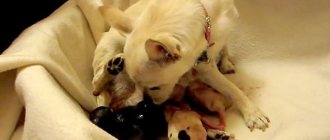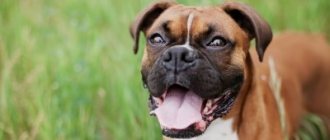The main problems associated with the number of teeth
Changing teeth in a Pomeranian is a complex and lengthy process. Baby teeth have a long root, and the number of molars is much greater than puppy teeth. If the change is incorrect, one of two problems may occur due to the incorrect number of teeth:
- Polyodontia is an excess of teeth. It occurs when a Spitz’s baby teeth do not fall out, but the molars are already growing or have grown. The teeth do not have enough space on the jaw, and they are arranged in a checkerboard pattern, which in turn is called dystopia. In this case, the baby teeth are removed. But if the growing teeth have already deviated greatly to the side, then an incorrect bite cannot be avoided. The main thing is to remove the baby tooth in a timely manner.
- Oligodontia – lack of teeth. The absence of a pair of molars is allowed. The absence of any other tooth indicates a serious problem. If teeth do not appear for a long time, you can take an x-ray to see if there are tooth root buds in the gums. If it is detected, the gum is slightly incised to make it easier for the tooth to erupt. Typically, oligodontia is observed just at the age when the Spitz's teeth change, especially at 5-6 months of life. In this case, the baby teeth have successfully fallen out on their own, but the molars have not yet erupted.
When do puppies change teeth?
The dentition of an adult dog has 42 teeth. The first signs of the appearance of “needle” teeth can be observed at the age of three to four weeks, and all teeth emerge by the end of the seventh to eighth week. The milk set consists of 28 (14 teeth on each jaw) or 32 (16 teeth), depending on the genetic characteristics, breed of the pet, as well as the number of puppies in the litter and the quality of feeding.
- baby fangs appear on days 20-25;
- after 12-15 days the incisors grow;
- The last to appear are the premolars, approximately between 35 and 60 days from birth.
The replacement of baby teeth in puppies begins at the moment when the first baby teeth take their place, that is, approximately from the end of the third month from birth. It is impossible to answer exactly how many months a complete replacement will take - most often it means the first year of a dog’s life (in more detail for large dogs - from 9 to 12 months, for small breeds - from 10 to 11 months).
- Between 13 and 16 weeks of age, the anterior incisors are replaced. The incisor hooks fall out first, followed by the middle ones and the edges last.
- Around the fifth month, the puppy's first molars appear immediately behind the premolars. They did not have a “milk” basis and do not allow the dentition to shift during the period of replacement of false roots.
- Between 24 and 32 weeks of birth, the premolar teeth change.
- At 24-28 weeks, simultaneously or after the change of premolars, the canines change.
- Over the course of 28 to 36 weeks, the remaining new, strong molars emerge.
The main problems associated with bite
The formation of the bite must be monitored from the age of 4 months to 7. The incisors are the first to change, the canines are the last. The normal bite of a Spitz is when the fangs of the upper jaw slightly overlap the fangs of the lower jaw. The bite has two main disorders:
- Snack. In case of overbite, the incisors of the upper jaw are hidden behind the incisors of the lower jaw. This deviation is called the “bulldog jaw.”
- Underbite. In case of underbite, the teeth of the lower jaw are located much deeper in the oral cavity. This makes it difficult for your pet to chew both natural products and store-bought food.
What is correct bite
The dog's bite must be correct, because otherwise the appearance of the animal will be spoiled, and dental problems may also develop. An underbite may appear - with it there is a significant gap between the lower and upper jaw. Polyodontia is another possible deviation in which redundant supernumerary teeth appear. They can even be located outside the oral cavity.
Misalignment appears in a situation where there is not enough space for all the incisors. Because of this, the holes are shifted in a checkerboard pattern.
If a Spitz has a malocclusion, then it should not be allowed to participate in the exhibition. Accordingly, it will not be possible to breed it. It’s better to solve the problem right away than to experience inconvenience because of it later.
Disease Prevention
Taking care of your teeth is an integral part of proper Pomeranian care. It is difficult to get an adult Spitz to start brushing its teeth. You need to raise your pet from childhood so that brushing its teeth simply becomes a habit for it. The bite must be monitored carefully. In case of a marked problem, you need to immediately contact a veterinarian, who will tell you whether surgical intervention is necessary, or the problem will go away on its own. Regular teeth cleaning is a must. It can be done at home, quickly and not at all expensive. Before brushing your Spitz's teeth, you need to stock up on everything you need.
Types of bites
The concept of “correct bite” is individual for each individual breed; what is good for a Bulldog is a disqualifying defect for a German Shepherd. In a global sense, cynology distinguishes the following types of bites:
- Orthognathia, scissor or normal - the front of the lower incisors touches the back of the upper incisors, see photo below. There is no gap between the incisors, however, the teeth do not rub against each other. The bite is called normal due to its naturalness and prevalence. All wild canids have a scissor bite, which allows them to effectively gnaw meat and bones, bite and hold prey. Almost all service dogs have a normal bite, for example, Labrador, German and other shepherds, hunting dogs, hounds.
- Pincer-shaped or straight - when the jaw is closed, the front incisors come together end-to-end, the canines and chewing teeth close completely or not completely. Direct bite affects the health of the incisors, which wear out much faster. Incomplete closure of the chewing teeth leads to problems with chewing food, and as a result, indigestion. A very common deviation for small breeds, for example, Chihuahua, Yorkie, Spitz.
- Progenia, overshot, protruding chin or bulldog bite - the lower jaw, respectively, the incisors and/or canines protrude in front of the upper ones. Undershot is a breed trait for a number of dogs with a short muzzle, such as the Boxer.
- Prognathia or undershot is a disqualifying fault for all known dog breeds. The lower incisors do not touch the upper ones due to the shortened lower jaw.
- An asymmetrical or skewed bite , like an underbite, is guaranteed to disqualify a dog from breeding. Additionally, an asymmetrical bite can have serious consequences on both your dog's appearance and health.
Toothpaste
Toothpastes for dogs are completely safe; your pet can easily swallow it. After brushing, the paste does not need to be washed off; it will foam and cover the teeth with a layer of protection. Typically, such pastes have a meaty flavor, which makes the cleaning process pleasant for the pet. If the paste gets on the wool, you just need to wipe it off or rinse it. It is strictly forbidden to brush your Spitz's teeth with human toothpastes. Having swallowed such toothpastes, the Spitz may get mild poisoning, after which the Spitz will have to be trained, rather than re-accustomed to brushing its teeth.
Dental care for adult dogs
Basic Rules:
- We brush our teeth 3-4 times a week with a special paste and brush. Ordinary human accessories are absolutely not suitable. Pomeranians can easily eat toothpaste, and rough brushes will damage their gums. Buy dog paste containing chlorhexidine or another antiseptic in specialized stores. The brush should be soft and of a suitable size;
- Cleaning your teeth will be better if you remove plaque from top to bottom rather than horizontally. Plaque will not remain between the teeth;
- To help prevent dental disease, use chewing toys and hard meat chips. Make sure that the surface is not too rough, as there is a danger of damaging the enamel. Important! These are auxiliary products and do not replace cleaning, but only complement it ;
- If tartar appears, yellowing of teeth, or bad breath, visit a doctor. He will clean using ultrasonic or laser equipment;
- The Pomeranian Spitz is not enthusiastic about the process, but tolerates the procedure calmly if the environment around him is comfortable. Create a ritual with a game or treat after the procedure and your dog’s teeth will be fine.
Difficulties with teeth are more understandable to people, but claws left uncontrolled cause great inconvenience to the baby.
Why don't Spitz teeth fall out?
This problematic change of teeth in Spitz dogs is provoked by certain characteristics of the breed. There are three main reasons that explain problems with changing teeth and bite:
- Genetics. An irregular jaw is inherited and passed on for several generations. The pet breeder should pay attention to the pedigree to know whether to immediately contact a veterinarian.
- Narrow jaw. Spitz teeth are relatively large. On such a narrow and thin jaw, the molars need more space, and the baby teeth have a long and strong root.
- Number of molars. It is quite difficult to place 42 teeth instead of 28. Because of this, some molars have a hard time erupting, even when other molars are in the way.
- Weak chewing muscles. The load on a Spitz's teeth is always small, because the muscles of the jaw are poorly developed. This is purely due to the size of the breed, which was originally bred to be a cozy dog.
Change of teeth in small breed puppies.
Some dog breeds have the characteristic feature of replacing teeth with permanent ones.
German Shepherd
The replacement of baby teeth in German Shepherd puppies begins at the height of the period of active growth. From about 14 weeks of age, the pet begins to grow rapidly and mainly increase in size abruptly, and small teeth are replaced by impressive, strong fangs.
- The incisors are the first to grow, usually between 13 and 20 weeks.
- Then comes the turn of the fangs - they appear from 20 to 32 weeks.
- Simultaneously with the growth of the canine, chewing teeth - molars - appear.
- Premolars fall out between 24 and 32 weeks of birth.
Yorkshire Terrier
York is a rather problematic breed not only in terms of health, bite formation, but also the change of teeth in puppies. This dog's milk supply begins to change to permanent around the third month of birth.
- First, the primary incisors are replaced, and then the canines. During this, an unpleasant odor may come from the pet's mouth, and the gums may bleed.
- Ideally, complete replacement of the milk line should stop by six, maximum by eight months of age. If this does not happen, then immediately contact a specialist to avoid all sorts of complications with your pet’s health.
The pattern for changing teeth depends on the subspecies of Spitz. The larger the dog, the lower the risk of problems associated with milk replacement.
- The Spitz's first teeth erupt by the age of one month. As a rule, puppies of this breed have a full set of teeth by the 8-12th week of birth - 28 milk teeth.
- The change of teeth in Spitz puppies begins at three months of age and follows a standard pattern.
- The complete replacement of milk with molars is completed by the 32-36th week from the puppy’s birth.
Labrador
- The timing of teeth change in Labrador puppies is classic - from 16 to 32 weeks.
- The Labrador has the correct bite - exclusively scissors.
- The slightest malocclusion is considered as a defect, but oligodentia for this breed is not a disqualifying sign.
French Bulldog
Good teeth are one of the most important advantages of this breed. The replacement of baby teeth in French bulldog puppies occurs on an individual basis.
- The standard period takes from 12 to 28 weeks. In some children, the replacement of the baby teeth occurs quickly and painlessly - the teeth fall out on their own and change literally one after another, in others the gaps between the lost teeth are very long.
- There are situations when the milk line does not have time to completely change until 1 year, but such a pathology is extremely rare.
Spaniel
The change of teeth in spaniel puppies begins when they reach 12-24 weeks of age and continues until 28-32 weeks from birth. When the molar row begins to grow, it causes irritation to the puppy and swelling of the gums.
- First, the incisors are replaced - this takes from 12 to 24 weeks.
- Next, the replacement of premolars begins. Since they do not have roots, you can easily help your pet and loosen them to get rid of them faster. Replacement of premolars lasts until 28-32 weeks of a puppy's life.
- Simultaneously with the replacement of premolars, the replacement of canines and the eruption of molars begins.
- Sometimes teeth can begin to grow before the baby teeth fall out, forming a second row. In this case, it is necessary to help the animal get rid of them so that the bite is not damaged in the future.
The milk line in this breed begins to erupt already at the 4th week of life. A characteristic feature of the dachshund is the fact that the fangs are the first to grow.
- The milk teeth of dachshund puppies are very weak and fragile, since they do not have roots, so their replacement occurs gradually already at 13-16 weeks of age.
- The molar row most often appears completely by the 24-32nd week from the dog’s birth.
| beginning of teeth change | the upper incisors have already changed |
However, it is not enough to buy a puppy with the correct bite; you also need to control the moment of teeth change in order to preserve it. Especially if you plan to participate in exhibitions and breeding in the future. The change of teeth in puppies of small breeds such as Pomeranian Spitz or Yorkshire Terrier occurs at approximately four months and three weeks of age.
I strongly recommend the removal of the four central upper teeth at this age, and it is necessary to remove the upper incisors even if they are not yet moving, because very often the upper molars begin to grow without “waiting” for the baby teeth to fall out. This needs to be done to make room for a new row of molars, so that they grow evenly and in their place, without overbiting. Strong-fitting upper baby teeth have large roots that can interfere with this.
But I categorically do not recommend simultaneous removal of the lower incisors (you may hear this advice).
Firstly, they usually change themselves without problems,
and secondly, too much “freedom” in the dentition can lead to teeth growing unevenly, at an incorrect angle, which again can lead to an incorrect bite.
| The picture shows a situation that requires emergency intervention |
When removing fangs early, there is a high risk of leaving a root fragment in the jaw, this happens if the tooth is not yet “ready” for removal, for this reason I recommend removing primary canines only when the molars are equal in size to the primary canines - when the top line of the incisors is at 0. 3-0.4 mm below the top point of the new canine.
The lower primary canines must be removed when the molars are approximately half grown. If this is not done, there is a risk that the molar canine may rest against the palate and not fit into place “in the lock.”
It is very important to find a skilled veterinarian who will be able to avoid leaving a piece of root in the jaw when removing teeth.
It may happen that the teeth will change correctly and without the intervention of a veterinarian, but constant timely monitoring during this period is strictly necessary.
If you purchased a puppy from our kennel and you have the opportunity to visit us during the change of teeth, I will be happy to help. If you live far away and do not have the opportunity to come, timely sending close-up photographs of your baby’s “smile” by email or via Viber and WhatsUp will help me notice the problem in time and promptly recommend you tooth extraction or another solution.
Good health to all pets and their owners.
In our next article, I will talk about dog dental care and proper brushing.
Author Elena Gainulina,
veterinarian, dog handler RKF,
owner of the nursery "from Panda Sharm".
